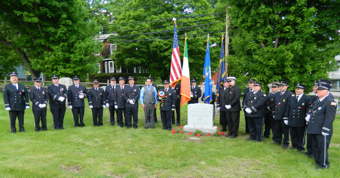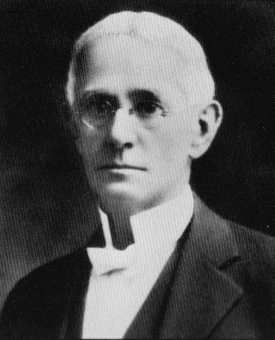 Former Ansonia Mayor Stephen Charters led a remarkable life that spanned eight decades and two continents — including a turbulent period in the city’s history that pitted city factory owners against the men they employed.
Former Ansonia Mayor Stephen Charters led a remarkable life that spanned eight decades and two continents — including a turbulent period in the city’s history that pitted city factory owners against the men they employed.
Charters, a carpenter from the city’s Fourth Ward, championed the working men en route to shocking the political establishment with an upset win in the 1901 mayor’s race.
He was also a founding member of the west side volunteer fire company that has borne his name for more than a century.
Two weeks ago Charters Hose firefighters dedicated a new memorial at Charters’ final resting place at St. Mary Cemetery to honor the man who made their existence a reality.
‘The Working Man’s Mayor’
Born in Limerick, Ireland on Christmas Eve, 1864, Charters eventually immigrated to New York City, where he worked as a carpenter for several years before settling in Ansonia.
Charters worked at the Farrel Corporation in the days when laborers received little respect, let alone Irish laborers such as Charters. The New York Times in 1901 pointed out that Charters was sure to fly his U.S. flag outside his home, even on St. Patrick’s Day.
He wasn’t just a factory employee, though. He was a union president, which didn’t make him especially popular with the titans of Ansonia industry in those days.
“Stephen Charters was a union organizer at Farrel’s, and generally a thorn in their side,” Robert Novak, a Shelton resident and a Valley historian, wrote in an email.
He entered Ansonia politics as a ward Alderman. In July 1901, during a workers’ strike at Farrel’s, he was arrested for convincing a few workers from crossing a picket line. “Conspiracy in a strike,” they called it.
At the time of his arrest, thousands of workers lined Ansonia streets to cheer him as he was loaded onto a train, according to the Boston Evening Transcript.
Charters waved a small American flag and yelled “Here’s for a shorter (work) day,” to the crowd before being hauled off to jail.
The arrest made him a local hero, and launched him into the mayor’s office.
His improbable victory reverberated throughout the region. The major newspapers of the day viewed him as a curiosity, with The New York Times describing him as a short man with an “aggressiveness in his manner, as if he is ready to fight for the fun of fighting.”
But the paper noted “he has the head of a thinker.”
Also, “his clothes fit him.”
Charters’ election was major news because the “carpenter mayor” appointed “trades union men” to city offices, the Times reported.
His victory was “quite a feat, considering he was a Democrat in what was then a largely Republican town,” Novak said.
In those days, Farrel wasn’t just the name of an Ansonia business. It was the name of the city’s dominant political group.
Article continues after document.
Valley United Way President Jack Walsh, a past president of the Derby Historical Society, put the challenge faced by Charters and his supporters in perspective.
“Farrel’s family would have been dominant in Ansonia at the time,” he said. “They must have been fearless to take (Farrel) on at that period in Ansonia’s history.”
Politics in the Charters-Farrel era wasn’t just controversial, it bordered on bloody. The city tax collector under Mayor Charters almost got into a street fight with an ex-Alderman.
“The politics in Ansonia were very polarized,” Novak said. “(Charters’) old nemesis from work, Alton Farrel, head of the corporation, was a major political force. In fact, it was Farrel who defeated him in the 1905 election. However, Farrel stepped down in 1906, propelling Charters back into office. From all indications, Charters and Farrel couldn’t stand one another, and there was a lot of dirty tricks going on,” Novak said.
 Charters also played an integral role in the creation of the fire company that now bears his name.
Charters also played an integral role in the creation of the fire company that now bears his name.
In 1909 a group of residents from the the city’s “Windy Hill” section — around Murray and Grove streets — began the Fourth Ward Association, a fire department that was the precursor to Charters Hose Company.
At the time, there was only one firehouse, the Fountain Hose Company #1, on the west side of the city, so the Fourth Warders petitioned Aldermen to recognize the new fire company in 1910.
Charters, a west side resident himself, supported the plan, and the Aldermen recognized the new fire company in February 1911.
Two months later, the fire company was renamed in Charters’ honor “for the tireless effort and help he had given to the membership’s existence.”
According to the company’s official history, “The vote was unanimously accepted and Mayor Charters, present at the meeting, thanked the membership for the honor and stated that he would continue to aid the company. At this meeting the membership cried out loud ‘WE’LL STAND TOGETHER, OR IF WE FALL … WE’LL FALL TOGETHER!’”
Those words are the company’s motto to this day.
Click here to read more about the company’s history.
The New Memorial
But, as the fire company celebrated its 100th anniversary in 2009, members realized they didn’t know where their namesake was buried.
So James Sheehy, a local attorney who is also an honorary captain and past secretary at Charters Hose, began a search for Charters’ grave.
He found it at St. Mary’s Cemetery in Ansonia.
Charters’ final resting place wasn’t marked by a headstone, so the firefighters commissioned one from Seccombe Brothers Memorials.
A smaller grave marker had been placed near the graves of Charters and his wife, but the name on it referred to a member of the former mayor’s extended family buried in the same group of plots.
“He was more or less in an unmarked grave,” said Ed Norman, a captain at Charters Hose.
“We thought as part of our anniversary celebration to put up a fitting memorial to a guy who had quite a background individually as a working man and as mayor of Ansonia,” Sheehy said.
The process to do so took a little longer than they realized — Sheehy had to petition the city’s probate court to reopen Charters’ estate, then get himself appointed as its temporary administrator to get permission to install a new headstone — but the new monument was commissioned last year.
On May 25, more than 30 firefighters, cub scouts, and others gathered at St. Mary Cemetery for a ceremony unveiling a headstone at the burial plot of Charters and his wife, Hannah.
The company’s members “just thought it was right to do something to honor” Charters, Norman said, noting Charters lived in a house a stone’s throw across Wakelee Avenue from the cemetery.
Click the play buttons on the videos below to see a portion of the ceremony, led by Sheehy.
“We are here today to dedicate this memorial stone to our namesake,” Sheehy said.
After Charter Hose chaplain Fr. Jeffrey Gubbiotti blessed the headstone, the company’s members stood at attention while a bugler played “Taps.”
Current Mayor David Cassetti put his predecessor’s legacy simply after participating in last month’s service at Charters’ grave.
“He was the working man’s mayor,” Cassetti said. “May he rest in peace.”
A photo gallery from last month’s ceremony is below.